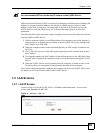
P-2304R-P1 Series User’s Guide
97
CHAPTER 8
NAT
Use these screens to configure port forwarding and trigger ports for the ZyXEL Device. You
can also enable and disable SIP, FTP, and H.323 ALG. See Appendix F on page 259 for more
background information about NAT.
8.1 NAT Overview
8.1.1 Port Forwarding: Services and Port Numbers
A NAT server set is a list of inside (behind NAT on the LAN) servers, for example, web or
FTP, that you can make accessible to the outside world even though NAT makes your whole
inside network appear as a single machine to the outside world.
Use the NAT Port Forwarding Screen to forward incoming service requests to the server(s) on
your local network. You may enter a single port number or a range of port numbers to be
forwarded, and the local IP address of the desired server. The port number identifies a service;
for example, web service is on port 80 and FTP on port 21. In some cases, such as for
unknown services or where one server can support more than one service (for example both
FTP and web service), it might be better to specify a range of port numbers.
In addition to the servers for specified services, NAT supports a default server. A service
request that does not have a server explicitly designated for it is forwarded to the default
server. If the default is not defined, the service request is simply discarded.
See Appendix H on page 283 for examples of services.
For example., let's say you want to assign ports 21-25 to one FTP, Telnet and SMTP server (A
in the example), port 80 to another (B in the example) and assign a default server IP address of
192.168.1.35 to a third (C in the example). You assign the LAN IP addresses and the ISP
assigns the WAN IP address. The NAT network appears as a single host on the Internet.


















